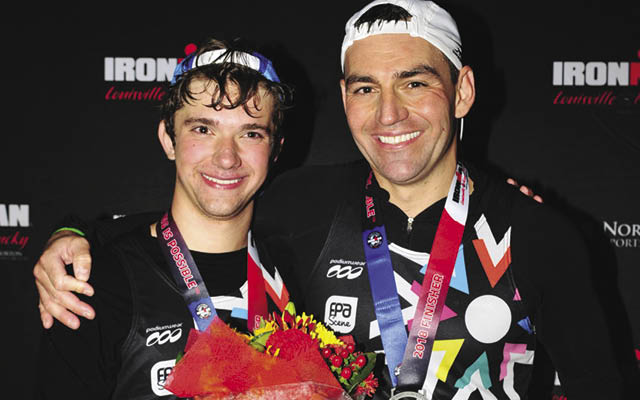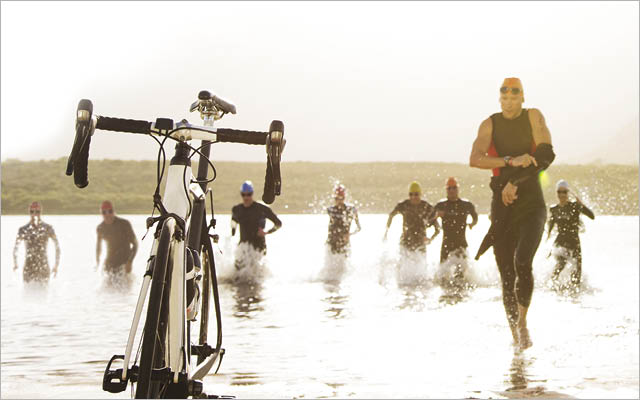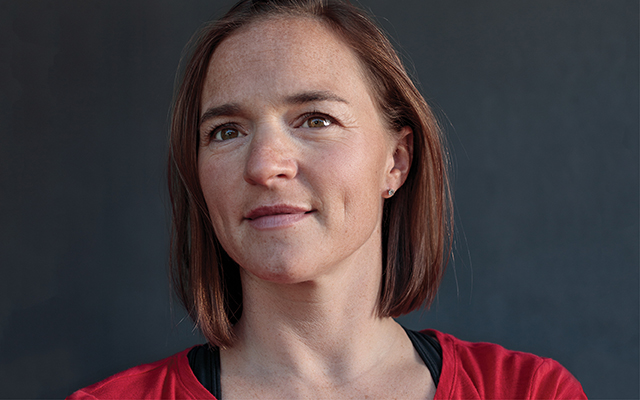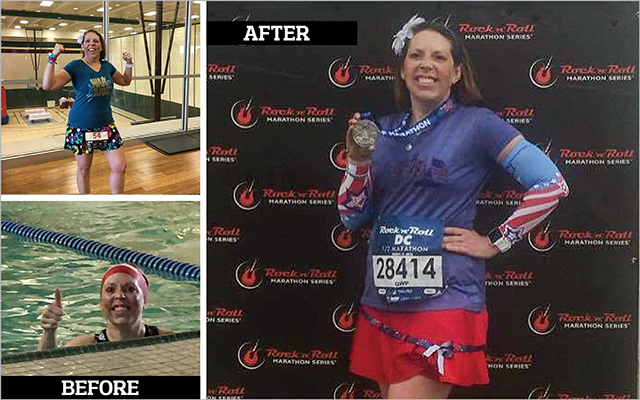Tethered to my guide, I could not see the course in front of me, but I could hear cheers of encouragement from the spectators. It was the summer of 2017, and I was competing in the Life Time Triathlon Minneapolis as a visually impaired athlete. I knew before I even crossed the finish line that I would race again. Although it would be days before I spoke the words out loud, I wanted to complete an Ironman: a 2.4-mile swim, 112-mile bike ride, and 26.2-mile run.
I’d begun losing my vision 12 years earlier as a 5-year-old. Eventually, I was diagnosed with Stargardt disease, a genetic condition that causes progressive degeneration of the retina. It’s a rare disease, affecting one in every 8,000 to 10,000 people. The gene is recessive in both of my parents, but no one as far back as we knew had it.
Many people assume that a blind person sees only darkness, but 85 percent of people who are legally blind have some vision. What is left of mine is on the periphery, which isn’t clear even for people with good vision. The spot in the middle — the space I can’t see — grows and changes.
Through grade school and middle school, I played soccer at recess and competed on the swim team. I was even in a golf league. The only adaptation I needed was a friend to keep track of my ball.
There were definitely times when I struggled, like when I turned 16 and my friends were getting their driver’s licenses. I allowed myself to be sad, then I accepted the situation and moved on.
Blindness is part of me. If I weren’t blind, I wouldn’t have so many cool opportunities, which outweigh the things I can’t do. I always try to focus on what’s possible. Another way I cope is through humor; you don’t hear many people joke about being blind.
I started Louie’s Vision, my nonprofit, in 2016 to improve the quality of life for other visually impaired kids. We give them more life experiences and build their confidence by hosting events like yoga, hiking, and golf outings. We share real, everyday stories about blindness that aren’t about being a superhero or being helpless. There’s a lot in between — I’m proof of that.
What’s Possible
Within days of finishing that Life Time triathlon, I approached my parents about doing an Ironman. They said no immediately. I was a strong swimmer, but I had biked only 30 miles and run only as far as six miles. Plus, I wanted to accomplish this goal before I went to college, which didn’t give me a lot of time. Most Ironman athletes train for years.
I stayed persistent, and my parents eventually allowed me to register for the Louisville Ironman in 2018. Their only conditions were that I had to figure out the details and find myself a guide.
It was challenging to find someone willing to do the race as well as train with me. Finally, I found Milan Tomaska through Facebook connections. While he had never met a blind person before or been a guide, he was a 10-time Ironman finisher. I was eager to experience the race through his eyes.
Milan caught on quickly and was able to prepare me for all sorts of things: sidewalk cracks, curves, low-hanging branches. I never fell but I had a few close calls. Once Milan yelled during a trail run, “Watch out, there’s a pineapple coming up!” I thought he was joking. A few seconds later, I tripped over a pineapple.
Milan was willing to do whatever it took to help me improve and get me over the finish line. His heart was always in the right place. Knowing that motivated me to keep going.
Over the Finish Line
After fighting off a fever the night before, I woke on race day feeling doubtful. The elevators in the hotel didn’t work. The ride we’d scheduled didn’t show. We walked two miles to the starting line in the pouring rain. I was cold and miserable, and my nerves were like nothing I had experienced before.
Race officials postponed the start because of the current in the Ohio River and ultimately shortened the swim to one mile, all downstream. Once we were in the river, I struggled to spot off Milan because the water was murky and dark. I had to poke my head up more than usual and could feel the band connecting us tugging at me.
Running through the transition was unwieldy. We unclipped our tether and tried to move quickly, taking care not to trip. Milan is used to doing transitions in a minute or less. We spent almost 10 minutes in the tent changing into our bike gear.
Biking is mentally hard for me because it’s kind of boring. When sighted people bike they can focus on the road, but riding on the back of a tandem for me is like being on a stationary bike.
It was 45 degrees and raining, and my hands were so cold I couldn’t grasp my water bottle. The second transition took twice as long.
I was so happy to get off the bike that I was actually looking forward to running a marathon, which I never thought I’d say.
Halfway through the marathon, I felt that “runner’s fog.” I could hardly see anything in my periphery, and I couldn’t understand anything Milan said. But I trusted him so much that sometimes I closed my eyes, because that felt more comfortable.
There were so many people in the last stretch. I could tell from the noise. I didn’t see the finish line, and I couldn’t hear Milan telling me to stop, so I kept running. Because we were tied together, Milan couldn’t stop either. Finally, I landed in the arms of a volunteer “athlete catcher.” I finished in 12 hours, 58 minutes, and 52 seconds.
Between Hero and Helpless
I hugged my family first. I wasn’t the only one who had put in time to reach my goal: My parents, my sister, and Milan all had spent so much time supporting me; that kind of behind-the-scenes effort often goes overlooked. I was incredibly grateful for them in that moment.
The first-place finisher gave me his bouquet of roses. “For me, this is a job,” he said. “You showed me what this race is really about.” My intention had been to motivate other blind kids, so I was surprised I had also made an impression on the guy who won.
The feeling of finishing was incredible. I don’t know if I’ll ever feel that way again. Even if I do another Ironman, it won’t be like my first.
With that accomplishment behind me, now I’m concentrating on going to college. While I want to be an example and show blind kids they can set ambitious goals, I also want to inspire them to do the ordinary things that bring joy to their everyday lives: going to a concert, their school dance, or a camping trip.
Someday I might do another Ironman, but regardless I will compete in the Life Time Triathlon Minneapolis. It’s become my summer tradition. Even if I move away, I’ll always come home to finish the race that got me started.
Louie’s Top 3 Success Strategies
1) Don’t try to go from A to Z. It’s all about the effort between those steps. “Blindness can create more steps,” Louie says, “but never lose sight of the goal.”
2) Think about what’s possible. There will always be something negative getting in the way, even for able-bodied people. “Focus on what you can do, and put your effort into that,” he advises.
3) Never be afraid to ask for help. “Getting help doesn’t make you helpless — it prevents you from being helpless,” Louie explains. Asking for what he needed was an important step in reaching his goal.
Q&A with Ironman Guide Milan Tomaska
We learned about this 10-time Ironman finisher’s experience guiding a blind athlete to the finish line through Louie McGee’s story in the July/August 2019 issue. We sat down with him to learn more about what the race was like through his eyes.
Experience Life | How did you first hear about Louie’s need for a guide?
Milan Tomaska | I found out through Facebook. A couple of my friends were connected to Louie, and they had shared a post about Louie looking for a guide.
I’ve had a lot of experience with racing an Ironman, but I have never been a guide for a visually impaired athlete. As soon as we met, we clicked. It also helped that we live fairly close to each other, only about 10 miles apart, so it was a perfect fit.
EL | What motivated you to choose to help him?
MT | It was a not difficult decision for me. I never thought of guiding somebody in a race like this, but as soon as I saw Louie’s post, I knew I had to take the opportunity. Triathlon is such an individual sport, and having the chance to help someone else achieve their goal of finishing an Ironman was a challenge I felt ready for.
In getting to know Louie, I also learned about all of the great work his nonprofit does for the community. I realized that his goal was so much bigger than just finishing an Ironman — and I wanted to help him bring awareness to other visually impaired kids and show them that anything is possible.
EL | Practically speaking, how do you guide a blind person through a swim, bike, and run?
MT | So the race starts with the 2.4 mile swim, and we were tethered by a bungee cord at our ankles. When we first started training, our issue was trying to find that perfect rhythm between the two of us. The cord is only 2 feet long, so there were times when we would just bump into each other, or hit each other in the head.
We also started swimming in May, so the water was still cold, and Louie’s never really done any open-water swimming. It’s very different from pool swimming, so that was an adjustment for him. Still, he was a strong swimmer, and the water portion went really well for us.
We biked on a tandem bicycle, which Louie had some experience with before we started training. I’d never been on a tandem bike — I don’t think I’d even really seen one before, so that experience was brand new for me. We started with his lower-end commuter bike, but after our first ride, I knew it wasn’t meant for longer distances. We needed a different bike, but Louie wasn’t prepared to spend a few thousand dollars on a racing tandem for just one event.
So, we went back to social media. I posted on several bike forums about Louie’s story and our need to borrow a bike. The response was overwhelming. We had hundreds of comments from total strangers offering different bikes, and eventually we found one that was the right fit for us.
I think from Louie’s perspective, he struggled with the bike a bit more. He wasn’t as strong with cycling as he was with swimming, but with both of us pedaling, we got through it.
For the run, we were tethered together with a cord at our hips. Most of Louie’s running had been in a track and field setting — a lot of shorter distances, maybe some more intense sprints. He wasn’t really accustomed to the pace of longer distances, and a marathon is a really tough event just on its own. So to add a long day of swimming and biking in front of it, it’s just a completely different animal. We put a lot of our training hours into practice runs.
EL | During the race, not only did you have to communicate to Louie, but you also had to be visually aware for both yourself and for him. How did you balance those tasks?
MT | The swim was tricky from a communication perspective. We realized early on that we couldn’t really hear each other in the water, and so basically I just had to pull him left or right when we needed to change course. Similarly, on the bike, I was doing all the steering — Louie was my engine, pedaling away in the back.
I struggled on the run, especially at the beginning of the training. My role was really to talk Louie through what was coming up, and early on, I didn’t realize how intense that was going to be. I had to match my pace to his pace, which I knew, but I also had to be on the lookout for curbs, bumps, and turns, so I could warn him ahead of time.
Louie has no forward vision, but peripherally, he can see a bit — and sometimes that realm of his vision plays tricks on him. So, if we would be running on a sunny day underneath some trees, he would see some shadows and that would startle him, because he felt like he was about to run into something. I’d have to really point out those elements to him.
EL | And you’re a seasoned Ironman athlete. Was part of your role also to cheer him on?
MT | That was especially true during the running portion. Just like anybody, when you’re getting tired and your body is giving up midrace, your mind is giving up as well. My job then was to find a way to help Louie remember his goal and to encourage him to push through.
EL | It’s a huge task, to be someone’s eyes in an event like this. Was there ever a point during training when you felt maybe you’d gotten in over your head, or uncertain if you’d be able to pull it off?
MT | Honestly, I never even felt like that would happen. It was challenging, but as soon as I had couple of workouts with Louie, I realized that he was going to get to that finish line no matter what. He is such a determined person — especially for being so young, he has done so much in his life — and I knew if he just put his mind to it, he would be able to do it. It really never crossed my mind that we wouldn’t complete the race.
EL | So, as a 10-time finisher yourself, you’ve been in and around Ironman racing for some time. How was this race different for you?
MT | In all my prior races, I was competing — either against the other participants, or against my personal record. This race was something entirely different. It was about enjoying the experience and helping Louie accomplish his goal. We had really miserable, cold, rainy conditions, and as we were racing and trying not to think about the weather, we could hear all these people cheering us on — family members, spectators, or the volunteer aids. Emotionally, it was a totally different experience. It was way bigger than me, and way bigger than an Ironman.
This originally appeared as “Ironman Vision” in the July/August 2019 print issue of Experience Life.




This Post Has One Comment
You are an inspiring individual. I have a lot of admiration and respect for the things you have accomplished! This will touch the lifes of many. Especially those with a loss of sight. I would like to talk sometime.